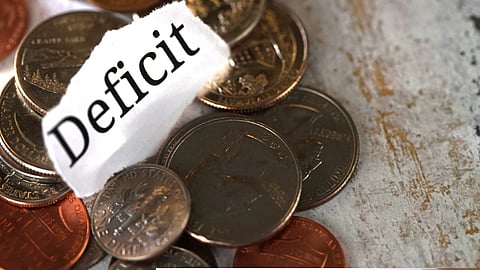

When you spend more than you earn, you borrow. If this borrowing keeps rising without control, what happens then? One of the biggest concerns for stock markets is the budget deficit. This isn’t something markets watch only when the budget is presented; they remain alert to it throughout the year. Every announcement about government spending and every update about revenue is closely tracked.
Why this constant watchfulness about the deficit? The answer lies in the very nature of a deficit. When the budget shows a shortfall, the government turns to borrowing. But that debt has to be repaid with interest. Over time, this burden has only been increasing. Many countries, including India, are already weighed down by large levels of debt.
The government mainly borrows from the domestic market. When this happens, the funds available for private entrepreneurs shrink. This is not good for economic growth. Banks and financial institutions generally prefer lending to the government. There is little worry about repayment—after all, it is the government that is borrowing.
When lending to the government, the interest rate is usually lower. Banks make up for this loss by charging higher interest on other loans. As a result, entrepreneurs face reduced access to credit and a heavier interest burden. Naturally, in such an environment, only businesses and industries with large profit margins can manage to survive.
These are not the only reasons behind the concern over rising deficits. There is also the question: what if debt grows to a point where repayment becomes impossible? To assume that such a situation can never happen to countries or governments would be a mistake. It is true that this usually does not occur, but it is not unheard of either.
Even so, almost all nations today spend more than they earn, funding the excess through borrowing. If this borrowing grows unchecked, what then? That is exactly what the markets are asking.
India, with debt amounting to 83% of its GDP, and the United States, with 123%, both face this pressing question. At the top of the debt list stands Sudan with 252%. Japan follows with 235%, Singapore at 175%, and Greece—long known for its financial struggles—at 142%.
Harvard economist and noted author Gregory Mankiw recently addressed this issue during the Martin Feldstein Memorial Lecture at the National Bureau of Economic Research in Massachusetts, USA. He examined five possible outcomes if debt rises excessively:
Unusual growth: Investment expert Cathie Wood argues that average GDP growth could rise from 3% to 6%. If that happens, debt is less of a concern. But Mankiw assessed that such a favourable scenario is highly unlikely.
Default: Many countries—including Russia, Greece, and Argentina—have taken this route. But it is never smooth; default brings international shame and isolation.
Currency crisis: If governments try to print money to escape, inflation can spiral out of control. In recent times, even a 100-trillion Zimbabwean dollar note could not buy a single meal.
Spending cuts: The bulk of most national budgets goes to interest payments, defence, social welfare, and healthcare. None of these are easy to reduce.
Higher taxes: The remaining option is raising taxes. Though unpopular, it may be the only practical path forward. European nations, where tax revenue exceeds 40% of GDP, show the way—Mankiw suggested that the US and others may have to follow.
In short, when the government spends beyond its income, the people (including businesses) must shoulder the burden through higher taxes. For individuals, heavier taxes mean less money to spend, enjoy, save, or invest. Fewer people will put money into shares, dragging markets down.
For companies, higher taxes shrink profits and reduce earnings per share (EPS), which naturally drives share prices lower. This is the link between deficits and markets: only when deficits are contained can taxes remain lower, companies grow more profitable, individuals have more to invest, and stock markets rise.
The combined liabilities of the central government, state governments, and external borrowings are shown here as a percentage of GDP for each year:
Year – Percentage
2018–19 – 70.4%
2019–20 – 75.1%
2020–21 – 87.8%
2021–22 – 83.0%
2022–23 – 81.3%
2023–24 – 80.4%
2024–25 – 79.6%
A deficit simply means government borrowing. It arises whenever expenditure exceeds revenue. Ever since nations began keeping and publishing records of income and spending, deficits have existed. Taxes, fees, and other sources of income have rarely been enough to cover all expenses. In such cases, governments borrowed money—from wealthy individuals, institutions, or sometimes even from other countries. When the term ended, the debt had to be repaid with interest.
In earlier times, this borrowing was mostly resorted to during wars or natural disasters. Later, however, it became common even in normal circumstances. By itself, this is not necessarily a problem, since national income also tends to grow over time, allowing repayment.
In the age when coins were made of gold, silver, and other metals, some rulers resorted to deceit—reducing the weight of coins or lowering the proportion of precious metal in them. In the modern era, this manipulation took a different form. Instead of direct borrowing, governments printed money without restraint to cover deficits. This led to a fall in the value of the currency, rising inflation within the country, and weaker exchange rates against foreign currencies.
After some time, countries stopped printing money to cover deficits. The IMF and the World Bank also compelled nations to abandon that practice. As a result, the deficit had to be fully met through borrowing.
Governments now issue bonds and raise funds from banks and insurance companies. They also borrow from provident fund deposits and money collected through various government savings and investment schemes. When this is still not enough, they turn to borrowing from abroad. This is the system in place today.